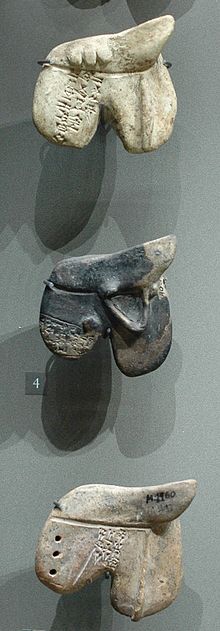Liver inspection
The liver viewing ( Greek : hepatoscopy ) was one of the central and most widespread practices of the sacrificial viewing in ancient oracles and omen and still occasionally plays a role in some traditional Asian cultures today. As a hepatomantie also divination from the liver, performed by a haruspex .
The liver review is often part of a hieroscopy , also hieromanty, a fortune telling from sacrificial material (from ancient Greek ἱερός hieros "holy", "sacrifice" and ancient Greek μαντεία manteia "fortune telling"). It joins a number of divinatory processes that try to predict the future using sacrificial material.
origin
The Babylonians saw the liver as the main part of the intestines and next to the heart as the central organ of life, as a microcosm in which the will of God manifests itself as in the macrocosm. To explore this will, a special sacrificial animal ( sheep ) was slaughtered for the sacrificial show and then the appearance of the liver was interpreted by properly trained sacrificial showers.
interpretation
The victim shuddered the right side of the liver to refer to the client's relationships, the left side to the foreign relationships. The liver has been divided into different regions called the mountain, river, road, palace, ear, leg, finger, tooth, vulva, and testicle of the liver. Unusual holes in the liver were considered an omen, which advised caution.
Lore
The oldest surviving evidence of the liver show comes from the time of the Assyrian King Sargons I and the Akkadian ruler Naram-Sins . Historical events were interpreted in omens , e.g. B .:
- if the surface of the liver is [like] a lion, it is an omen of Sargon, who came up under that omen [in the aeon of Ištar ] and had no adversary or adversary. His shine on [he poured out the lands]. He crossed the sea of the west; three years in the west [all countries] captured his hand ....
- when the surface of the liver such as ... and the gallbladder and pyramidal process are absent, the gallbladder duct is long and encloses the surface of the liver, [it is an omen] of Sargon, who expanded his palace to five miles in circumference ...
- When the surface of the liver surrounds the gallbladder to its extent and the lower tip falls over it and the bladder falls behind the surface and is stuck there, it is an omen of Sargon, who went to the country ... and subjugated the country ... and whose hand thus conquered the four parts of the world.
Other peoples
Oment texts and practices of the Babylonian liver review were adapted from neighboring cultures ( Hurrites , Elamites , Hittites ) and were also formative for the Indian, Egyptian, Greek and Etruscan traditions (see Haruspex ). The Aztecs were also familiar with the sacrifice show and, similar to the Babylonians, the liver was given a central role as the seat of life (see Mictlantecuhtli ).
See also
literature
- Rosmarie Leiderer: Anatomy of sheep liver in the Babylonian liver oracle: A macroscopic-analytical study. Zuckschwerdt, Munich [a. a.] 1990, ISBN 3-88603-348-1
- Jan-Waalke Meyer: Investigations on the clay liver models from the ancient Orient. Butzon and Bercker, Kevelaer / Neukirchener Verlag, Neukirchen-Vluyn 1987 (= Old Orient and Old Testament, 39), ISBN 3-7666-9554-1 , ISBN 3-7887-1271-6
- Hans Lorenz Stoltenberg: The most important Etruscan inscriptions: text, translation and explanation. Gottschalksche Verlagbuchhandlung, Leverkusen 1956
- Ulla Koch-Westenholz: Babylonian Liver Omens: The Chapters Manzāzu, Padānu Pān Tākalti of the Babylonian Extispicy Series mainly from Ašššurbanipal's Library . The Carsten Niebuhr Institute of Near Eastern Studies, Copenhagen 2000 (= CNI Publications, 25), ISBN 87-7289-620-5
Web links
- The Etruscan Bronze Liver (English)



